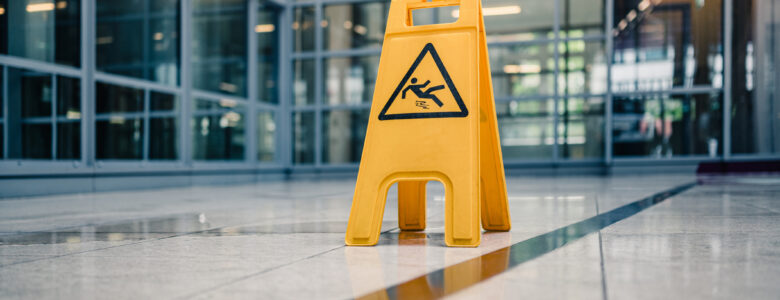Safety in the workplace, for employees and customers/visitors alike, is a substantial concern for any business. With slips, trips, and falls prevalent in the workplace and on business premises, it is important for business owners to take precautions to help prevent these types of accidents from happening. Based on statistics from the National Floor Safety Institute, while slips and falls do not constitute a primary cause of fatal occupational injuries, they do represent the primary cause of lost days from work. Twenty-two percent of these incidents resulted in more than31 days away from work.
In 2023, falls accounted for over eight million hospital emergency room visits, which represents the leading cause of visits. This constitutes 21.3% alone. Within this category, slips and falls contribute significantly, constituting over 1 million emergency room visits, or 12% of the total falls.
In this article, we will assess some potential legal exposures for businesses resulting from fall incidents. In order to bring about a safer environment, businesses and individuals also need to understand the dynamics of slip-and-fall and trip-and-fall accidents that can be mitigated through effective preventative measures.
Can My Business Be Liable for Slip, Trip & Fall Accidents?
It is an important part of workplace safety and risk management to protect against liability for slip and/or trip and fall accidents. To better understand their roles and responsibilities and take preventative action, businesses should be familiar with a number of legal concepts.
The establishment of legal liability depends upon a variety factors, such as the circumstances of an incident, property conditions, and the duty to care owed to people when on business premises.
- Premises Liability: Among the main legal concepts pertinent to slip, trip, and fall cases for non-employees (e.g. customers and visitors) is the concept of premises liability. Businesses are required by law to provide a safe environment for their customers and other guests. As a general matter, property owners have a duty to keep their premises free from dangerous conditions or situations. In the event an individual slips or trips and falls due to a dangerous situation on the business’s premises, responsibility (and liability) for the injury will likely be that of the property owner. This necessitates keeping relatively safe surroundings, quickly resolving any possible threats or conditions, and properly notifying people about them.
- Negligence: Legal negligence is a key component of premises liability claims. Legal negligence has four primary components: (1) the existence of a duty of care to another person; (2) a breach of that duty of care; (3) the breach of the duty is the proximate cause of the injury; and (4) damages resulting from the proximate cause. Potential slip, trip and fall exposures that could lead to legal negligence include poor maintenance, failure to timely clean up spills, failure to post signage of potential trip hazards, improper maintenance of parking areas and sidewalks, unreasonable delays in clearing snow and ice hazards, and other lack of care regarding known hazards.
- Visitor Status: The first element of negligence is the existence of a duty of care, so the nature of an individual’s legal status on the premises is also relevant in this context. Those lawfully on the premises, such as customers and other visitors, are considered “invitees” in most cases. Other statuses include a licensee and a trespasser. For each, there is a different degree of legal protection.
- a) Naturally, invitees, such as customers or clients, are your responsibility and are owed a higher duty of care. This involves ensuring that they are not exposed to any known or reasonably discoverable dangers.
- b) Licensees, who enter the property for their own purposes with permission, also warrant a duty of care.
- c) Trespassers receive less protection, but property owners may still have some responsibilities, especially if the trespasser is a child.
- Providing Liability: In order to establish liability, the plaintiff must generally provide evidence that the business owner (or its employees) was aware or should have been aware of a potentially hazardous condition and failed in exercising reasonable caution toward it. Extensive safety procedures, periodic premises inspections and maintenance, quick response to possible hazards as well as warnings, if necessary, can all help companies proactively reduce liability exposure. Workers’ Compensation and Employees: as a general rule, employee injuries occurring within the course and scope of employment are compensated through workers’ compensation. As such, the sole remedy for such an injured employee is found within the applicable state workers’ compensation rules, rather than under principles of legal liability. Workers’ compensation insurance is designed to respond to these injuries, by providing indemnity payments for loss time benefits and covering related medical expenses. That said, employers of injured workers still face challenges and likely increased costs when employees are out of work due to injuries. Additionally, the frequency and severity of claims can impact how much the business owner pays for its workers’ compensation insurance.
How Do I Protect Against Fall Hazards for My Employees?
Fall protection for employees requires a planned approach to prevent hazards. Here are a few key measures that can enhance fall prevention:
- Regular Risk Assessments: Frequent assessments should be carried out for the identification and elimination of slip, trip and fall hazards in jobs. This involves assessing floor surfaces, stairs steps and workspaces to reduce risks.
- Employee Training: Offer a detailed training program in fall prevention highlighting the correct use of safety equipment, identification of hazards and safe work practices.
- Use of Safety Equipment: Provide employees with safety clothing including anti-slip shoes, and where appropriate, harnesses, and guardrails to boost the level of protection against falls.
- Clear Communication: Implement clear communication about safety procedures and possible dangers. Place signage and instructions on priority safety in the relevant sections to remind employees.
- Regular Maintenance: Make sure that proper maintenance is carried out regularly. Repair of damaged or dangerous walking surfaces should be done promptly. In addition, promptly address spills and obstacles to avert slips, trips and falls.
- Safety Policies: Develop and enforce safety policies that specifically address fall prevention. The prompt reporting of potential hazards by employees should be motivated to enable timely interventions.
- Access to Safety Resources: Give easy accessibility to safety resources, such as training materials, contingency plans and reporting of concerns regarding subject matter.
By taking measures such as these along with a strong safety culture, companies can greatly reduce the risk of slip, trip and fall injuries, creating an environment that is safe for employees.
What Are Some Common Types of Insurance to Help Mitigate the Business Risks of Slip, Trip, and Fall Claims?
There are several forms of insurance that businesses utilize to help guard themselves against slip, trip and fall claims.
As the base foundation, a key coverage is commercial general liability insurance that provides protection against liabilities (including premises liability) for items such as medical costs and damages stemming from slip, trip and fall injuries.
Umbrella or excess liability policies provide another layer of protection of liability insurance, providing additional limits of insurance beyond underlying primary liability policies, such as a commercial general liability policy.
Another important insurance is workers’ compensation insurance for employees injured on the job. Workers’ compensation benefits include medical benefits, rehab support and indemnity for wage loss to claimants in cases of slip, trip and fall injuries suffered in the course and scope of employment.
Conclusion
Businesses should always strive to keep their business premises safe and free from dangerous conditions. In addition to protecting people from injury, implementing sound risk management practices, properly maintaining premises, and procuring the appropriate insurance policies can greatly help mitigate against legal exposures resulting from slip, trip and fall incidents.
There for You: Acadia Insurance
At Acadia, we’re all about helping businesses throughout the Northeast thrive. Our mission is to provide superior service and product as close to you as possible, providing you with the coverage you need to proceed with confidence. We are committed to proactive risk management and comprehensive financial protection.
We understand what you want most from your insurance is security and peace of mind. That means knowing you are working with an insurance provider who will support you every step of the way to help you protect your business.
With Acadia, not only can you get coverage tailored to your needs, but you will also receive support from dedicated claims professional to guide you through the claims process in the event of a loss. That way, you know exactly what to expect. Knowing your claim professional by name and a handshake – that’s “Closer Coverage.” Get to know ore about how we work and find an agent near you by going to the Find an Agent section on our public website (www.acadiainsurance.com).




